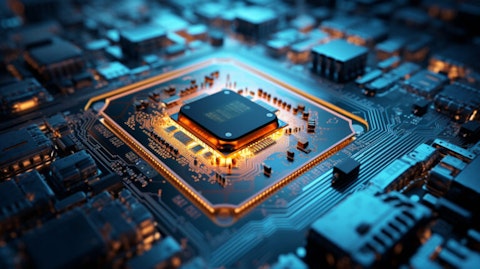Advanced Micro Devices, Inc. (NASDAQ:AMD) Q3 2023 Earnings Call Transcript October 31, 2023
Advanced Micro Devices, Inc. beats earnings expectations. Reported EPS is $0.7, expectations were $0.68.
Operator: Greetings, and welcome to the AMD Third Quarter 2023 Earnings Conference Call. At this time, all participants are in a listen-only mode. A brief question-and-answer session will follow the formal presentation. [Operator Instructions] As a reminder, this conference is being recorded. And it is now my pleasure to introduce to you Mitch Haws, Vice President, Investor Relations. Thank you, Mitch. You may begin.
Mitch Haws: Thank you, John, and welcome to AMD’s third quarter 2023 financial results conference call. By now, you should have had the opportunity to review a copy of our earnings press release and the accompanying slides. If you had not had the chance to review these materials, they can be found on the Investor Relations page of amd.com. We will refer primarily to non-GAAP financial measures during today’s call, and the full non-GAAP to GAAP reconciliations are available in today’s press release and slides posted on our website. Participants on today’s conference call are Dr. Lisa Su, our Chair and Chief Executive Officer; and Jean Hu, our Executive Vice President, Chief Financial Officer and Treasurer. This is a live call and will be replayed via webcast on our website.

A semiconductor chip with intricate circuitry, highlighting the company’s tech capabilities.
Before we begin, I would like to note that Forrest Norrod, Executive Vice President and General Manager, Data Center Business Solutions unit, will attend the UBS Technology Conference on Tuesday, November 28. AMD will host its Advancing AI Event on December 6, when AMD and its key ecosystem partners and customers will showcase the AMD products and partnerships that will shape the advancement of AI. The event will be live streamed on our website. Jean Hu, Executive Vice President, Chief Financial Officer and Treasurer, will attend the Barclays Global Technology Conference on Thursday, December 7. And our fourth quarter 2023 quiet time is expected to begin at the close of business on Friday, December 15. Today’s discussion contains forward-looking statements based on current beliefs, assumptions and expectations, speak only as of today and as such, involve risks and uncertainties that could cause actual results to differ materially from our current expectations.
Please refer to the cautionary statement in our press release for more information on factors that could cause actual results to differ materially. With that, I will hand the call over to Lisa. Lisa?
Lisa Su: Thank you, Mitch, and good afternoon to all those listening in today. We executed well in the third quarter, delivering strong top line and bottom line growth, achieving multiple milestones on our AI hardware and software road maps and significantly accelerating our momentum with customers for our AI solutions. In PCs, there are now more than 50 notebook designs powered by Ryzen AI in market, and we are working closely with Microsoft on the next generation of Windows that will take advantage of our on-chip AI Engine to enable the biggest advances in the Windows user experience in more than 20 years. In the Data Center, multiple large hyperscale customers committed to deploy Instinct MI300 accelerators, supported by our latest ROCm software suite and the growing adoption of an open hardware-agnostic software ecosystem.
Looking at the third quarter financial results, revenue grew 4% year-over-year and 8% sequentially to $5.8 billion, driven by record server CPU revenue and strong Ryzen processor sales. Turning to the segment results. Data Center segment revenue of $1.6 billion was flat year-over-year and up 21% sequentially as solid demand for both 3rd and 4th Gen EPYC processor families resulted in record quarterly server processor revenue. We gained server CPU revenue share in the quarter as 4th Gen EPYC CPU revenue grew more than 50% sequentially, crossing over to represent a majority of our server processor revenue and unit shipments. In cloud, while the demand environment remained mixed in the quarter, EPYC CPU revenue grew by a strong double-digit percentage sequentially as hyperscalers expanded deployments of EPYC processors to power their internal workloads and public instances while optimizing their infrastructure spend.
Nearly 100 new AMD-powered cloud instances launched in the quarter from Amazon, Google, Microsoft, Oracle, Tencent and others, including multiple general instances that deliver leadership performance for general purpose, HPC, bare metal and memory optimized workloads. In enterprise, while overall demand remains soft, we are seeing strong indications that the significant performance and TCO advantages of Genoa and our expanded go-to-market investments are paying off as enterprise revenue grew by a double-digit percentage sequentially. We closed multiple new wins with leading automotive, aerospace, financial services, pharmaceutical and technology customers, and the number of enterprise customers actively testing EPYC platforms on-prem increased significantly quarter-on-quarter.
We also expanded our 4th Gen EPYC processor portfolio with the launch of our Ciena processors that deliver leadership energy efficiency and performance for intelligent edge and telco applications. Dell, Lenovo, Super Micro and others launched new platforms that expand our EPYC CPU TAM to address telco, retail and manufacturing applications. With the launch of Ciena, we now offer the industry’s most performant and most energy-efficient portfolio of server processors across cloud, enterprise, technical, HPC and edge computing. I am very pleased with the momentum we have built for our EPYC CPU portfolio. We are building on this momentum with our next-gen Turin server processors based on our new Zen 5 core that delivers significant performance and efficiency gains.
Turin is in the labs of our top customers and partners now, and customer feedback has been very strong and we’re on track to launch in 2024. Looking at our broader Data Center portfolio, we made significant progress in our Data Center GPU business in the third quarter as the multiyear investments we have made in our hardware and software road maps resulted in significant customer traction for our next-generation Instinct MI300 accelerators and particularly our Instinct MI300X GPU that delivers leadership inferencing and training performance. On the hardware side, bring-up and validation of our MI300A and MI300X accelerators continue progressing to plan with performance now meeting or exceeding our expectations. Production shipments of Instinct MI300A APUs started earlier this month to support the El Capitan Exascale supercomputer, and we are on track to begin production shipments of Instinct MI300x GPU accelerators to lead cloud and OEM customers in the coming weeks.
On the software side, we further expanded our AI software ecosystem and made great progress enhancing the performance and features of our ROCm software in the quarter. In addition to ROCm being fully integrated into the mainline PyTorch and TensorFlow ecosystems, Hugging Face models are now regularly updated and validated to run on Instinct accelerators and other supported AMD AI hardware. AI start-up, Lemon.ai announced they achieved software parity with CUDA for LLMs running on Instinct MI250 GPUs, enabling enterprise customers to easily deploy production-ready LLMs fine-tuned for their specific data on Instinct MI250 GPUs with minimal code changes. We also strengthened our AI software capabilities with the strategic acquisitions of Mipsology and Nod.ai.
Mipsology is a long-standing partner with proven expertise delivering AI software and solutions running on top of our adaptive SoCs for data center, edge and embedded markets. Nod.ai adds a highly experienced team with a track record of substantial contributions to open-source AI compilers and industry-leading software already used by many of the largest cloud enterprise and AI companies. Nod’s compiler-based automation software can significantly accelerate the deployment of highly performant AI models optimized for our Instinct, Ryzen, EPYC, Versal and Radian processors. Based on the rapid progress we are making with our AI road map execution and purchase commitments from cloud customers, we now expect Data Center GPU revenue to be approximately $400 million in the fourth quarter and exceed $2 billion in 2024 as revenue ramps throughout the year.
This growth would make MI300 the fastest product to ramp to $1 billion in sales in AMD history. I look forward to sharing more details on our progress at our December AI event. Turning to our Client segment. Revenue increased 42% year-over-year and 46% sequentially to $1.5 billion. Sales of our Ryzen 7000 processors featuring our industry-leading Ryzen AI on-chip accelerator, grew significantly in the quarter as inventory levels in the PC market normalized and demand began returning to seasonal patterns. Revenue for our latest-generation client CPUs powered by our Zen 4 core more than doubled sequentially as we saw strong demand for our Ryzen 7000 Series notebook and desktop processors that deliver both leadership energy efficiency and performance across a wide range of workloads.
In commercial, we launched our first Threadripper Pro workstation CPUs based on our Zen 4 Core that deliver unmatched performance for multi-threaded professional design, rendering and simulation applications. Dell, HPE and Lenovo announced an expanded set of workstations powered by new Threadripper Pro processors as we focus on growing this margin-accretive portion of our client business. Looking forward, we are executing on a multiyear Ryzen AI road map to deliver leadership compute capabilities built on top of Microsoft’s Windows software ecosystem to enable the new generation of AI PCs that will fundamentally redefine the computing experience over the coming years. Now turning to our Gaming segment. Revenue declined 8% year-over-year and 5% sequentially to $1.5 billion as lower semi-custom revenue was partially offset by increased sales of Radeon GPUs. Although semi-custom SoC sales declined in line with our projections for this point in the console cycle, overall revenue for this console generation continues tracking significantly higher than the prior generation based on strong demand for Microsoft and Sony consoles.
In Gaming Graphics, revenue grew both year-over-year and sequentially, driven by increased demand in the channel. We expanded our Radeon 7000 series with the launch of new RX 7000 Series enthusiast desktop GPUs that offer leadership price performance for 1440p gamers. Turning to our Embedded segment. As we expected, revenue decreased 5% year-over-year to $1.2 billion. Sequentially, revenue declined 15% as lead times normalized and customers focused on reducing inventory levels. We expanded our leadership Versal SoC portfolio in the quarter with the launches of our first adaptive SoCs with on-chip HBM memory that deliver significant performance and efficiency for memory-bound data center, network, test and aerospace applications. We also announced our next-generation space-grade Versal SoC that integrates an enhanced AI Engine and is the industry’s only solution that supports unlimited reprogramming during development and after deployment.
For the fintech market, we launched our latest Alveo Accelerator card that delivers a 7x improvement in latency compared to our prior generation and has already been deployed by multiple trading firms in their ultra-low latency training platforms. Since closing our acquisition of Xilinx a little over 1.5 years ago, our Embedded business has grown significantly, driven by our leadership products. Looking ahead, based on our current visibility, we expect Embedded segment revenue to decline sequentially as customers continue working through elevated inventory levels through the first half of 2024. Over the medium term, we see strong growth opportunities for our Embedded business based on our significant design win traction and our broad and differentiated portfolio of embedded FPGAs, CPUs, GPUs and adaptive SoCs that can address a larger portion of our customers’ compute needs.
In summary, I’m pleased with our third quarter financial results, driven by the significant acceleration of Zen 4 server and client processor sales. Looking at the next couple of quarters, we expect strong growth in our Data Center business, driven by both EPYC and Instinct processors. This growth will be partially offset by softening demand in our Embedded business and lower semi-custom revenue, given where we are in the console cycle. As the PC market returns to seasonal patterns, we believe we are well positioned to gain profitable share in the premium and commercial portions of the market based on the strength of our product offerings. We are focused on accelerating our leadership AI capabilities across our entire product portfolio, executing on our hardware and software road maps and expanding our enterprise computing footprint.
I look forward to sharing more details on our AI progress in a few weeks at our together we advance AI event. Now I’d like to turn the call over to Jean to provide additional color on our third quarter results and our outlook for Q4. Jean?
Jean Hu: Thank you, Lisa, and good afternoon, everyone. I’ll start with a review of our financial results for the third quarter and then provide our current outlook for the fourth quarter of fiscal 2023. We delivered better than expected third quarter results with revenue of $5.8 billion and diluted earnings per share of $0.70. On a year-over-year basis, revenue increased 4% as growth in the Client segment revenue was partially offset by lower Gaming and Embedded segment revenue. Revenue was up 8% sequentially, driven by growth in both the Client and the Data Center segment. Gross margin was 51%, up approximately 1 percentage point year-over-year primarily driven by stronger Client segment revenue and product mix. Operating expenses were $1.7 billion, an increase of 12% year-over-year, primarily driven by higher R&D investment to support our significant AI growth opportunity.
Operating income was $1.3 billion, representing a 22% operating margin. Taxes, interest expense and other was $141 million. For the third quarter, diluted earnings per share was $0.70 compared to $0.67 in the same period last year. Now turning to our reportable segment. Starting with the Data Center segment, revenue was $1.6 billion, flat year-over-year as growth in the EPYC processor sales was offset by a decline in adaptive SoC product sales. Data Center revenue grew 21% sequentially, primarily driven by strong sales of our 4th Gen EPYC processors to both cloud and enterprise customers. Data Center segment operating income was $306 million or 19% of revenue compared to $505 million or 31% a year ago. Lower operating income was primarily due to increased R&D investment to support future AI revenue growth and product mix.
Client segment revenue was $1.5 billion, up 42% year-over-year, primarily driven by higher sales of Ryzen mobile processors. On a sequential basis, revenue grew 46% as PC market conditions continued to improve, and we ramped our Ryzen 7000 series to meet strong demand. Client segment operating income was $140 million or 10% of revenue compared to an operating loss of $26 million a year ago, driven by higher revenue and a disciplined OpEx management. We are pleased that the Client segment returned to profitability in the third quarter. Gaming segment revenue was $1.5 billion, down 8% year-over-year, primarily due to a decrease in semi-custom revenue, partially offset by increase in Radeon GPU sales. On a sequential basis, Gaming segment revenue declined 5%, in line with our expectations as we are now in the fourth year of the console cycle.
Gaming segment operating income was $208 million or 14% of revenue compared to $142 million or 9% a year ago, primarily driven by higher Radeon GPU revenue. Embedded segment revenue was $1.2 billion, down 5% year-over-year, primarily due to lower sales to the communication market. On a sequential basis, Embedded segment revenue declined 15%, primarily due to inventory correction at customers in several end markets. Embedded segment operating income was $612 million or 49% of revenue compared to $635 million or 49% a year ago. Turning to the balance sheet and the cash flow. During the quarter, we generated $421 million in cash from operations and the free cash flow was $297 million. In the fourth quarter, we expect to pay approximately $550 million in cash taxes, primarily due to previously deferred taxes from California disaster relief efforts made available by the IRS.
Inventory decreased sequentially by $122 million to $4.4 billion. At the end of the quarter, cash, cash equivalents and short-term investment was strong at $5.8 billion. We returned $511 million to shareholders, repurchasing 4.8 million shares and we have $5.8 billion in remaining share repurchase authorization. Now turning to our fourth quarter 2023 outlook. We expect revenue to be approximately $6.1 billion, plus or minus $300 million, an increase of approximately 9% year-over-year and 5% sequentially. Year-over-year, we expect revenue for the Data Center and the Client segments to be up by strong double-digit percentage, the Gaming segment to decline, given where we are in the console cycle, and the Embedded segment to decline due to additional softening of demand in the embedded market.
Sequentially, we expect Data Center segment to grow by strong double-digit percentage, Client segment revenue to increase and the Gaming and Embedded segment to decline by double-digit percentage. We expect non-GAAP gross margin to be approximately 51.5%, non-GAAP operating expenses to be approximately $1.74 billion, non-GAAP effective tax rate to be 13% and the diluted share count is expected to be approximately 1.63 billion shares. In closing, I’m pleased with our execution in the third quarter with year-over-year growth in revenue, gross margin and earnings per share. In the fourth quarter, we expect to benefit from strong Data Center and Client momentum, driven by MI300 AI accelerated ramp and the strength of our high performance leadership Zen 4 family of products despite lower sales in the Gaming segment and additional softening of demand in the embedded market.
Looking ahead, the investment we are making in AI across our Data Center, Client, Gaming and the Embedded segment enable us to offer one of the best industry’s broadest portfolio, targeting the most compelling opportunities and positioning us to drive long-term profitable growth. With that, I’ll turn it back to Mitch for the Q&A session.
Mitch Haws: Thank you, Jean. John, we’re happy to poll the audience for questions.
See also 11 Best Pharma Stocks To Buy Now and 25 Safest Exotic Places to Travel in the World.
Q&A Session
Follow Advanced Micro Devices Inc (NASDAQ:AMD)
Follow Advanced Micro Devices Inc (NASDAQ:AMD)
Operator: Thank you, Mitch. We will now be conducting a question-and-answer session. [Operator Instructions] And the first question comes from the line of Toshiya Hari with Goldman Sachs. Please proceed with your question.
Toshiya Hari: Great. Thank you so much. Lisa, I had two questions. My first one is on the Data Center GPU business. You talked about ’24 revenue potentially exceeding $2 billion. I was hoping you could provide a little bit more color. What percentage of this is AI versus supercomputing or other applications? Within AI, maybe talk about the breadth of your customer lineup. And how should we think about which workloads you’re addressing, again, within the context of AI? Is it primarily training or inference or both?
Lisa Su: Great. Thanks, Toshiya, for the question. So look, we’ve made significant progress on the overall MI300 program. I think we’re very happy with how the technical milestones look. And then also, we’ve made significant progress from a customer side. Your question as to how the revenue evolves, so the way to think about it is, in the fourth quarter, we said revenue would be approximately $400 million, and that’s mostly HPC with some — the start of our AI ramp. And then as we go into the first quarter, we actually expect revenue to be approximately similar in that $400 million range. And that will be mostly AI so with a very small piece being HPC. And as we go through 2024, we would expect revenue to continue to ramp quarterly, and again, it will be mostly AI.
Within the AI space, we’ve had very good customer engagement across the board from hyperscalers to OEMs, enterprise customers and some of the new AI start-ups that are out there. From a workload standpoint, we would expect MI300 to be on both training and inference workloads. We’re very pleased with the inference performance on MI300, so especially for large language model inference, given some of our memory bandwidth and memory capacity. We think that’s going to be a significant workload for us. But I think we would see a broad set of workloads as well as broad customer adoption.
Toshiya Hari: Thank you. And then as my follow-up, a question on the server CPU side. You talked about Genoa growing really nicely in the quarter. I think you talked about both units and volume being bigger than its predecessor. Is the growth that you’re seeing or the growth that you saw in Q3 and the growth that you’re guiding to for Q4, is this primarily a function of share growth or are you actually seeing a pickup in the overall market? And I ask the question because, obviously, year-to-date, there’s been a significant shift away from traditional compute to accelerated computing, but are you actually starting to see signs of stabilization or even improvement on the traditional compute side? Thank you.
Lisa Su: Sure. So the way I would frame it is we’re very pleased with our third quarter performance as it relates to EPYC overall. I think the 4th Gen EPYC, so that’s Genoa Plus Bergamo actually ramped very nicely. We got to a crossover in the third quarter, which is a little bit ahead of what we had previously forecasted. And when I look underneath that, I would say with a strong growth in both cloud. Cloud was strong so strong double-digits. The adoption is pretty broad across first-party and third-party workloads and new instances. And then on the enterprise side, we’ve also seen some nice growth across our OEMs. And so from the standpoint of, is it the market recovery or is it share gain? I think it’s some of both. From a market standpoint, I would say it’s still mixed.
I think enterprise is still a little bit mixed depending on sort of which region from a macroeconomic standpoint. Cloud depends a bit on the customer set. But overall, I think we’re pleased with the progress and the leadership of EPYC has ended up, allowing us to grow substantially in the third quarter and then into the fourth quarter.
Operator: And the next question comes from the line of Aaron Rakers with Wells Fargo. Please proceed with your question.
Aaron Rakers: Yeah. Thank you for taking the questions. Just to build off that last question, Jean, I think last quarter, you kind of endorsed the notion that your Data Center business would grow. I think it was in the high-single digit range. I think you started the year thinking like 10. So I guess the question is, do you still see that kind of growth rate setup? And how has that $400 million evolved underneath that? Has that — was it $300 million now going to $400 million? Just how has that changed over the course of the last quarter just to level set that Data Center expectation?
Jean Hu: Yeah. So I think for the second half, we said we expect Data Center business to grow approximately 50% versus first half. But right now based on what we are seeing, we continue to see in that similar range of that 50%. So we are very happy and pleased about the strong momentum of our Data Center business. On the GPU side, Lisa mentioned about $400 million, around $400 million. As we go through the quarter, we have a strong engagement with the customers. So we do see the progress continues and we see customers placing orders. So that’s why when we go through the quarter, we start to increasingly confident about the revenue profile in Q4 we are guiding.
Lisa Su: Yeah. And Aaron, if I could add to that — if I can just add to that. I think what we’ve seen is the adoption rate of our AI solutions has given us confidence in not just the Q4 revenue number but also sort of the progression as we go through 2024.
Aaron Rakers: Yeah. That’s helpful. And maybe just the follow-up, how would you characterize the supply side of the equation? As you look at that $2 billion number, do you feel confident that you’ve got adequate visibility in the supply side to hit those expectations, any update on that side?
Lisa Su: Sure, Aaron. So we’ve been planning the supply chain for the last year and we’re always planning for success. So certainly, for the current forecast of greater than $2 billion, we have adequate supply. But we have also planned for a supply chain forecast that could be significantly higher than that, and we would continue to work with customers to build that out.
Operator: And the next question comes from the line of Joe Moore with Morgan Stanley. Please proceed with your question.
Joseph Moore: Great. Thank you. Following up on the Data Center GPU, can you talk about the breadth of customers that you might see there? How — I assume it’s fairly concentrated in year one, but you also did mention multiple hyperscalers. Can you just give us a sense for how concentrated that might be?
Lisa Su: Yeah. Sure, Joe. So we’ve been engaging broadly with the customer set. I think in the last earnings call, we said that our engagements had increased 7 times and so there is a lot of interest in MI300. We will start, let’s call it, more concentrated in cloud, sort of several large hyperscalers. But we’re also very engaged across the enterprise and there’s a lot of interest. Our partnerships with the OEMs are quite strong. And when we think about sort of the breadth of customers who are looking for AI solutions, we certainly see an opportunity, especially as we get beyond the initial ramp to broaden the customer set.





